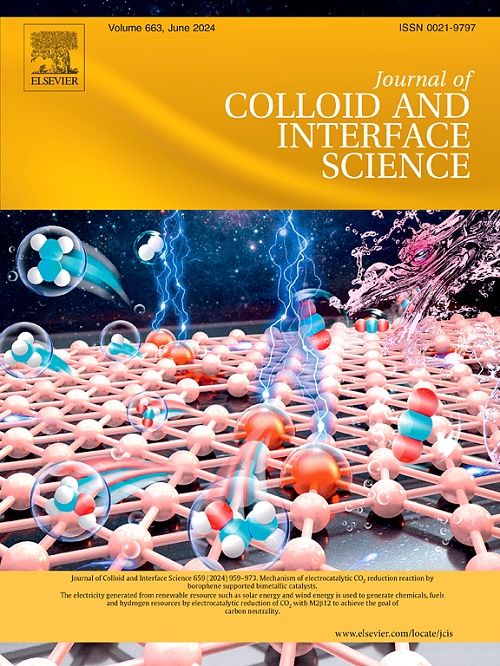Oil recovery enhancement by Nanobubbles: Insights from High-Pressure micromodel studies
IF 9.4
1区 化学
Q1 CHEMISTRY, PHYSICAL
引用次数: 0
Abstract
Hypothesis: Aqueous nanobubble solutions (NBs) have demonstrated a remarkable ability to displace hydrophobic fluids (e.g. oil) from porous media compared to blank water, although the underlying mechanisms remain unclear. Through detailed characterization of fluid behavior within porous spaces under controlled conditions, microfluidics can help uncover the fundamental origins of the NB-induced effects.
Experiments: We systematically evaluate the impact of NBs on two-phase flow dynamics within porous media by applying glass micromodels that mimic both extreme wettability conditions: strongly hydrophilic (water-wet “WW”) and strongly hydrophobic (oil-wet “OW”). An innovative system that combines membrane dispersion technique with microfluidic flow was used to generate NBs at elevated pressures for flooding tests.
Findings: In OW scenarios, NBs demonstrated superior sweep efficiency compared to distilled water, achieving more uniform front propagation and reducing bypassed oil volumes. The improvement can be attributed to the interfacial activity of NBs along with their specific interactions with solid surfaces. In particular, NBs lowered the interfacial tension (IFT) between the oil and aqueous phases, leading to weaker capillary forces that aid in effective oil mobilization. At the pore walls, NBs induced a slippage effect that reduced the pressure drop across OW media, further facilitating displacement. Aside from these fundamental insights, our results demonstrate the utility of N2 NBs for oil recovery and related applications at elevated pressures, which are often encountered in practical settings.

纳米气泡提高石油采收率:来自高压微模型研究的见解
假设:与空白水相比,含水纳米泡溶液(NBs)已经证明了从多孔介质中取代疏水流体(如油)的卓越能力,尽管其潜在机制尚不清楚。通过对受控条件下多孔空间内流体行为的详细表征,微流体学可以帮助揭示nb诱导效应的根本根源。实验:我们系统地评估了NBs对多孔介质中两相流动动力学的影响,通过应用玻璃微模型来模拟两种极端润湿性条件:强亲水性(亲水“WW”)和强疏水性(亲油“OW”)。将膜分散技术与微流体流动相结合的创新系统用于在高压下产生NBs进行驱油测试。研究结果:在OW情况下,与蒸馏水相比,NBs表现出了更高的扫描效率,实现了更均匀的前缘传播,减少了旁通的油体积。这种改进可归因于NBs的界面活性以及它们与固体表面的特定相互作用。特别是,NBs降低了油与水相之间的界面张力(IFT),导致有助于有效动员油的毛细力减弱。在孔壁上,NBs诱导了滑移效应,降低了OW介质的压降,进一步促进了驱替。除了这些基本见解之外,我们的研究结果还证明了N2 nb在高压下采油和相关应用中的实用性,这些应用在实际环境中经常遇到。
本文章由计算机程序翻译,如有差异,请以英文原文为准。
求助全文
约1分钟内获得全文
求助全文
来源期刊
CiteScore
16.10
自引率
7.10%
发文量
2568
审稿时长
2 months
期刊介绍:
The Journal of Colloid and Interface Science publishes original research findings on the fundamental principles of colloid and interface science, as well as innovative applications in various fields. The criteria for publication include impact, quality, novelty, and originality.
Emphasis:
The journal emphasizes fundamental scientific innovation within the following categories:
A.Colloidal Materials and Nanomaterials
B.Soft Colloidal and Self-Assembly Systems
C.Adsorption, Catalysis, and Electrochemistry
D.Interfacial Processes, Capillarity, and Wetting
E.Biomaterials and Nanomedicine
F.Energy Conversion and Storage, and Environmental Technologies

 求助内容:
求助内容: 应助结果提醒方式:
应助结果提醒方式:


